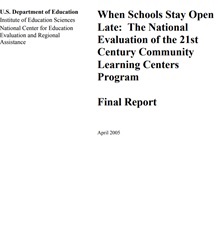When Schools Stay Open Late: The National Evaluation of the 21st Century Community Learning Centers Program
Contract Information
Current Status:
This study has been completed.
Duration:
September 1999 – April 2005
Cost:
n/a
Contract Number:
ED-99-CO-0134
Contractor(s):
Mathematica Policy Research
Decision Information Resources
Contact:
Reports
The 21st Century Community Learning Centers Program is a state-administered grant program to provide opportunities for academic enrichment to meet state and local student academic achievement standards in core academic subjects, such as reading and mathematics. This program is authorized as part of Title IV of the Elementary and Secondary Education Act and was funded at $1 billion in Fiscal Year 2008. The funding supports after-school programs and is targeted towards high-poverty schools, with priority given to schools in need of improvement.
Even though the percentage of public schools offering extended-day programs increased from about 13 percent to 47 percent between 1987 and 1999, research on the impact of after-school programs has been inconclusive. The purpose of this national evaluation was to describe the implementation of these programs and to provide high-quality estimates of their impact on student outcomes.
- Did 21st Century Community Learning Centers improve student outcomes, such as supervision after school, safety after school, academic achievement, behavior, and social and emotional development?
- What types of students benefited the most?
- What were the features and characteristics of programs?
This study had a purposive sample of 26 centers serving elementary school students in 12 districts, and a nationally representative sample of 61 centers serving middle school students in 32 districts. In the elementary school sample, students were randomly assigned to attend the center or not. In the middle school sample, students who attended centers were compared to similar students who did not attend the centers (quasi-experimental design). Students were followed for two consecutive school years beginning in 2000–01.
Data collection included surveys of parents, teachers, and students, examining school records, and administering the Stanford Achievement Test in reading to students. These data were collected at baseline and in two follow-up years to examine students' supervision after school, academic achievement, behavior, developmental outcomes, and feelings of safety after school. These data were compared between students assigned to attend the centers and comparison students to address the study's first two research questions. The third research question was primarily addressed by summarizing implementation data obtained through biannual site visits to centers during each of the two years of the study.
The final report, titled When Schools Stay Open Late: The National Evaluation of the 21st Century Community Learning Centers Program Final Report, was released in April 2005.
Other publications from this study are listed below.
- When Schools Stay Open Late: The National Evaluation of the 21st Century Community Learning Centers Program New Findings (October 2004)
- When Schools Stay Open Late: The National Evaluation of the 21st-Century Community Learning Centers Program First Year Findings (January 2003)
A restricted-use file containing de-identified data is available for the purposes of replicating study findings and secondary analysis.
Impacts
- Treatment students were more likely than comparison students to be supervised by other adults after school, and less likely to be supervised by parents and siblings; there were no differences between the groups in self-care.
- The Centers had few impacts on academic achievement, and there was no difference between the treatment and comparison groups in receiving homework assistance.
- Elementary students in the treatment group felt safer than elementary students in the comparison group.
- There were mixed impacts of the program on developmental outcomes.
- Treatment students were more likely than comparison students to engage in some negative behaviors.
Implementation
- The 21st Century Community Learning Centers mostly served low-income schools that enrolled large proportions of minority students. The most important center objectives were providing a safe setting and offering activities to help students improve academically.
- Many center staff were teachers. Program leadership was stable, but line staff turnover was high.
- The average elementary school student attended two to three days a week, and the average middle school student attended one day a week. Middle school students attended less frequently as the school year progressed, and most did not return in the second year even when they had access to centers. Elementary school students attended about the same throughout the year and were more likely to return in the second year.

